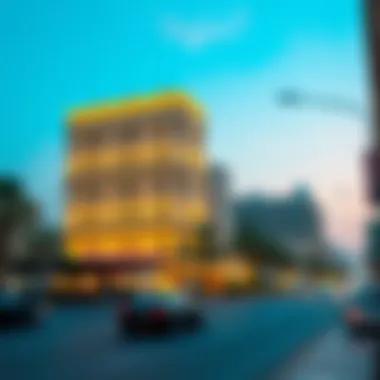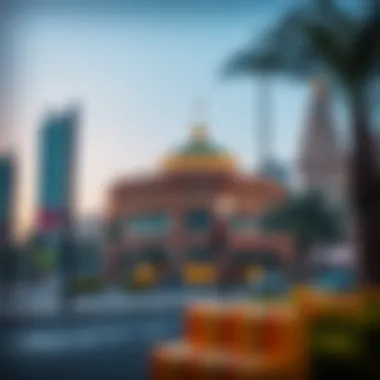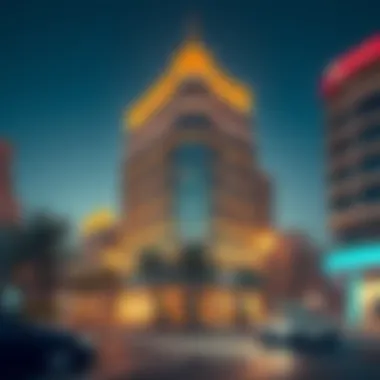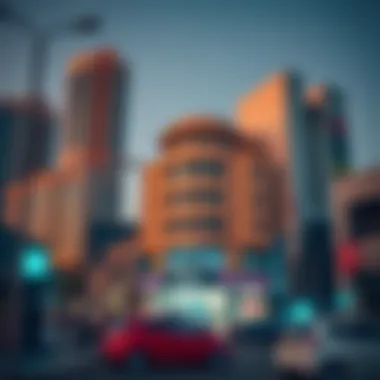Exploring the Cultural Impact of Hudaiba Building in Satwa


Intro
Nestled within the intricate urban landscape of Dubai, the Hudaiba Building stands as a beacon of cultural richness and architectural distinction. It is not merely a structure; it represents a convergence of history, community, and contemporary lifestyle, reflecting the myriad experiences of those who call this vibrant city home. As we delve into the essence of the Hudaiba Building, we will uncover its architectural significance, historical narrative, and its role as a social hub in the Satwa district.
Through the following sections, we will explore the cultural highlights that make the Hudaiba Building a unique landmark. From the traditions celebrated within its vicinity to the dynamic art and music scene that thrives here, we will paint a picture of how this building intertwines with the local spirit. Additionally, we will navigate the lifestyle and entertainment options available, showcasing the culinary and shopping delights that bring both residents and tourists to its doorstep.
Join us as we unravel the story of the Hudaiba Building, a testament to the cultural tapestry of Dubai, and discover how it continues to engage and inspire its community.
Prelude to Hudaiba Building
The Hudaiba Building is much more than just a structure; it represents a melding of history, culture, and community in the heart of Satwa, Dubai. This architectural landmark is an embodiment of the neighborhood's evolution while serving as a focal point for local gatherings and activities. Understanding the Hudaiba Building means immersing oneself into a vibrant narrative of community spirit and cultural significance.
Location and Accessibility
Nestled in the bustling Satwa district, the Hudaiba Building is conveniently located for both locals and visitors. Its proximity to public transport hubs like the World Trade Centre metro station makes it easily accessible. Moreover, the building is surrounded by a plethora of shops, cafes, and markets, creating a lively ambiance.
For visitors arriving from different parts of Dubai, getting to the Hudaiba Building feels effortless. The streets leading to it are well connected and often bustling with life, showcasing the vibrant nature of Satwa. A leisurely stroll from the nearby trade center can provide a glimpse into the day-to-day culture of the area. This means that whether one is a resident or a tourist, experiencing the Hudaiba Building is part of a broader exploration of the singular charm of Satwa.
Architectural Overview
The design of the Hudaiba Building is a fascinating mix of modern architectural trends and traditional influences. While the building may appear contemporary at first glance, it subtly incorporates design motifs that reflect the rich heritage of Emirati culture. The layout is functional yet aesthetically pleasing, inviting visitors to appreciate both its inner charm and exterior appeal.
Beyond its aesthetics, the Hudaiba Building showcases an intelligent use of space. Each floor is meticulously designed, balancing form and function in a way that promotes both community interaction and individual use. This thoughtful design has contributed significantly to its role as a cultural hub in Satwa.
"Hudaiba Building stands as a testament to the idea that architecture can nourish community and culture."
As you delve deeper into understanding the significance of the Hudaiba Building, you will find that it's not merely a point on the map; it's a place resonating with stories and experiences that contribute to the vibrant tapestry of Dubai's ever-evolving identity.
For those interested in the intersection of urban development and cultural heritage, exploring the Hudaiba Building is essential. This landmark serves as both a reflection of the past and a blueprint for the future of community-centric spaces in a rapidly changing urban landscape.
Historical Context of Satwa
Understanding the historical context of Satwa is crucial in appreciating the significance of the Hudaiba Building. This area is a reflection of Dubai's rapid transformation from a modest trading post to a bustling cosmopolitan hub. Satwa, which began as a small settlement in the early 20th century, has gradually evolved into a vibrant district combining rich traditions and modern dynamics.
Development of the Area
Satwa's growth can be traced back to the early days of the UAE, where it played a pivotal role in the trading routes that crisscrossed the region. As the city of Dubai expanded, Satwa emerged as a crucial residential area for expatriates and locals alike. Here, you can see houses that mirror a blend of modern architectural styles while still holding onto elements of traditional Emirati designs. This unique juxtaposition paints a vivid picture of how cultural diversity flourished in the face of urbanization.
- Population Growth: With the surge of laborers and professionals flocking to Dubai for opportunities, the population in Satwa swelled, particularly from the 1960s onwards. This demographic boom is integral to understanding the community's evolving character.
- Infrastructure Improvements: The influx of residents led to significant investments in infrastructure, transforming Satwa into a center for various services. Streets bustled with local businesses and eateries offering a tapestry of culinary delights.
- Accessibility Enhancements: With continuous efforts from the government, roads and public transport systems developed, making it easier than ever to get to and from Satwa.


As development progressed, landmarks like the Hudaiba Building became more than just physical structures; they became symbols of growth and cultural significance.
Cultural Significance
Satwa is a cultural melting pot, where different communities coexist and interact harmoniously. The area is known for its diverse population, representing a tapestry of nationalities contributing to a rich cultural landscape.
- Community Gatherings: The vibrant atmosphere in Satwa is often palpable, especially during festivals and community events. These gatherings foster a sense of belonging and togetherness among residents, making it a lively hub for networking and cultural exchange.
- Culinary Influences: The food scene in Satwa is emblematic of its cultural fabric. You can find an array of eateries showcasing flavors from the Indian subcontinent, the Philippines, and the Middle East. This diversity enriches the local culinary experience, drawing food lovers from across Dubai.
- Art and Expression: Local artists frequently showcase their work in community spaces, reflecting the dynamism of the area. Art exhibitions often take place in or around the Hudaiba Building, intertwining modern expressions with the historical roots of Satwa.
"Satwa is like a canvas, where every stroke of culture adds depth and color to Dubai's evolving story."
Architectural Features of Hudaiba Building
The architectural features of Hudaiba Building serve not only as a physical manifestation of design but also embody the cultural and historical essence of its surroundings. As Satwa continues to evolve within the dynamic landscape of Dubai, examining the building's features reveals an intricate connection to the community it serves. The design choices, materials utilized, and structural techniques all intertwine to create a narrative that both tourists and residents appreciate.
Design Elements
At first glance, Hudaiba Building captivates with its unique blend of traditional and contemporary design elements. The facade boasts intricate motifs that echo the rich cultural heritage of the region. Inspired by Islamic architectural principles, these patterns are not merely ornamental; they carry with them stories of the past, reflecting the values and artistic expressions of the local populace.
- High arches and spacious balconies create a welcoming vibe, effectively bridging indoor and outdoor spaces.
- The careful arrangement of windows allows natural light to flood the interior, fostering a sense of openness and tranquility.
- Large communal areas within the structure encourage gathering, which is vital in a community-oriented space.
These design elements not only beautify the building but also enhance its functionality, ensuring it remains relevant amidst the fast-paced changes in Dubai's urban fabric.
Materials and Techniques
The construction of Hudaiba Building involved a thoughtful selection of materials that cater to both aesthetic appeal and sustainability. Concrete and steel are predominant, offering durability while resisting the harsh desert climate. Moreover, the use of local stones adds an authentic touch, resonating well with the environment and conveying stability.
- Sustainable Practices: The building's architecture reflects a commitment to sustainability. The integration of green technologies, such as reflective glass and energy-efficient light fixtures, aligns with Dubai’s vision for future developments.
- Traditional Craftsmanship: Artisans employ age-old techniques, embedded in the region's history, ensuring that these skills are preserved for generations to come.
This blend of modern materials and traditional craftsmanship not only showcases progressive architectural thought but also holds significant historical value for the community.
Comparison with Nearby Structures
When placed alongside nearby structures, Hudaiba Building stands out as a beacon of thoughtful design. Unlike more modern skyscrapers that dominate much of Dubai's skyline, Hudaiba offers a contrast that emphasizes horizontal lines and layered textures.
- Proximity to Cultural Landmarks: Just a stone's throw away from other noteworthy sites such as Dubai’s textile market and Al Satwa’s charming cafes, Hudaiba's architecture serves as a reminder of the area’s roots.
- Cohesion with Local Character: While the glass facades of neighboring buildings can feel impersonal, Hudaiba’s use of earthy tones and handcrafted details fosters a sense of belonging and warmth.
"In a city defined by its rapid advances, Hudaiba Building proves that history and modernity can coexist harmoniously, reflecting the heart and soul of its neighborhood."
In summary, Hudaiba Building not only contributes to the architectural diversity in Satwa; it symbolizes the region's ongoing dialogue between the traditional and the modern. As one traverses through its corridors, the melding of design elements, innovative material choices, and conscious construction methods narrate a story that is both rich and inviting, solidifying its place as a cornerstone of the community.
Cultural Impact of Hudaiba Building


The Hudaiba Building not only serves as an architectural landmark in Satwa but also as a critical hub for cultural interactions within the community. It embodies the unique blend of tradition and modernity that defines Dubai. The building's cultural impact extends beyond its physical structure, influencing social behavior, community cohesion, and the promotion of the arts. The discussions surrounding the building's significance reflect a broader narrative of cultural identity in a rapidly evolving urban setting.
Community Interactions
One of the most noticeable contributions of Hudaiba Building is its role in fostering community interactions, especially among residents and expatriates. Its design encourages gatherings, whether informal meet-ups or organized events. The open spaces around the building often host local markets, food festivals, and art fairs that draw people from various backgrounds.
These engagements are crucial in a multicultural city like Dubai, where individuals from diverse backgrounds come together. They offer locals and expats a chance to share experiences, traditions, and cuisines. Such interactions not only help in breaking the ice between different cultures but also contribute to the emergence of a unified community identity. As people mingle, learn, and share, the cultural thread of Satwa strengthens, allowing for a richer social fabric.
"Community spaces like the ones around Hudaiba Building do not just bolster social interactions; they enrich our cultural landscape, ensuring no voice goes unheard."
Hudaiba Building’s proximity to various amenities enhances its attractiveness as a community gathering spot. For instance, nearby cafes and workshops facilitate discussions, whether on art, technology, or daily life. This synergy between the building and its surroundings nurtures a vibrant atmosphere that encourages collaboration and creativity among residents.
Art Exhibitions and Events
Art plays a pivotal role in shaping the cultural narrative within the community, and the Hudaiba Building often serves as a stage for various exhibitions and events. It showcases local artists, giving them a platform to display their work and connect with a wider audience. This not only elevates the profile of the artists but also fosters appreciation for the arts within a heterogenous audience.
Throughout the year, the building hosts workshops for different age groups, guiding how the local artists can translate their stories into visual art. These events become melting pots of ideas, where culture and creativity intersect.
Additionally, seasonal festivals, like the annual Satwa Art Fair, transform the building into a bustling venue, alive with activity. These occasions draw from the building's essence, amplifying its significance within the neighborhood. Art lovers, students, and curious minds converge here, turning each event into a collective celebration of creativity and community spirit.
Utilizing the unique features of the Hudaiba Building, such as its spacious halls and scenic terraces, these exhibitions often extend beyond the traditional format, incorporating interactive installations that invite participants to engage directly with the art. Through such engagements, attendees leave not only with a greater appreciation for the arts but also enriched personal connections that deepen their ties to the community.
In summary, the cultural impact of Hudaiba Building in Satwa transcends its architectural appeal. It nurtures community bonds and provides a canvas for artistic expression, embodying the heart and soul of local culture. The building stands as a testament to how architecture can bring people together, setting the stage for collaboration and creative exploration.
Hudaiba Building's Role in Modern Dubai
The Hudaiba Building holds a pivotal spot in the modern narrative of Dubai, acting not just as a physical structure but as a beacon of cultural identity and economic vitality. This section examines the various facets of its role in the city’s contemporary landscape, encompassing economic significance and its allure as a focal point for tourism. Understanding these elements provides insight into why the Hudaiba Building is more than a mere building; it’s a dynamic hub that enriches the local community and sparks interest from visitors globally.
Economic Significance
In the heart of Satwa, the Hudaiba Building contributes significantly to the local economy. Its strategic location allows businesses to thrive, creating job opportunities for residents and expatriates alike. Local shops, restaurants, and service providers benefit enormously from the foot traffic generated by the building's various activities.
The building is also a favorite among businesses seeking commercial space. Its design attracts startups and established companies alike, providing an environment that fosters innovation and collaboration. With a range of office spaces, both large and small, it supports a diverse spectrum of industries, thereby solidifying its role as a business hub in Dubai.
Moreover, the presence of the Hudaiba Building can enhance property values in the surrounding areas. Properties close to renowned structures often see a surge in demand due to their proximity to such a celebrated locale.
Tourism Attraction
The Hudaiba Building is not only a cornerstone of local economic activity but also serves as a significant attraction for tourists. Visitors to Dubai often seek a blend of modern architecture and cultural heritage. Hudaiba fits this bill perfectly.
Tourists are drawn to the building for its distinct architecture and rich cultural story, making it an ideal spot for photography and exploration. The area offers a taste of Dubai that contrasts with the glitzy skyscrapers and lavish shopping malls, showcasing a more traditional side of urban life.


Besides its architectural appeal, the building frequently hosts cultural events and exhibitions. This influx of events draws tourists looking to engage in local arts and culture, compelling them to explore nearby attractions and eateries, thereby elevating the overall visitor experience.
In essence, the Hudaiba Building stands as a vital intersection of economy and tourism in modern Dubai. Its dual role invigorates the local community while providing a glimpse into the city’s evolving identity, making it a noteworthy study in balancing commercial and cultural interests.
Sustainability and Future Developments
Sustainability is not just a buzzword anymore; it’s a necessity, especially in places like Dubai where development often outpaces environmental considerations. The Hudaiba Building has the potential to serve as a beacon of sustainable practices in urban construction and community-building. By exploring green initiatives and plans for future developments, we can appreciate how the Hudaiba Building aims to maintain harmony with its surroundings while serving the needs of its community.
Green Building Initiatives
In recent years, the Hudaiba Building has begun implementing various green building initiatives aimed at reducing its environmental impact. These initiatives include the use of eco-friendly materials, energy-efficient systems, and water conservation measures. For example, the installation of solar panels on the rooftop can help meet energy demands while significantly cutting down greenhouse gas emissions.
- Rainwater Harvesting: This system captures rain and reuses it for landscaping, thus conserving precious water resources in the arid environment of Dubai.
- Energy-efficient Lighting: By adopting LED technology, the building reduces energy consumption while providing optimal visibility.
The integration of these initiatives not only complies with local regulations promoting sustainability but also sets a valuable example for similar structures in the region. The Hudaiba Building demonstrates that urban spaces can thrive without sacrificing the earth’s health.
"Sustainability is not an option but a commitment to future generations. Hudaiba Building exemplifies this philosophy through innovative practices."
Plans for Renovation or Expansion
As the community around the Hudaiba Building evolves, so too do the plans for its renovation and expansion. Future renovations are geared towards enhancing the structural integrity and aesthetic appeal of the building while further integrating sustainable practices. One relevant aspect is the proposal to expand the communal areas, providing more space for local events and activities.
- Community Spaces: Plans may include the addition of more multi-functional community spaces that can host art exhibitions or workshops, directly enhancing cultural engagement.
- Smart Technologies: Future expansions could consider incorporating smart technologies for monitoring energy usage, which would add a layer of efficiency to the existing operations of the building.
This vision of expansion not only respects the historical significance of the Hudaiba Building but also acknowledges the community's dynamic needs and aspirations. By marrying sustainable practices with thoughtful renovations or expansions, the building can continue to serve as a pivotal nexus for culture and community.
Epilogue
The Hudaiba Building stands not just as a structure of bricks and mortar, but as a testament to the vibrant tapestry of life that defines Satwa and, broader still, Dubai. In this article, we've highlighted the multifaceted roles this iconic building plays in community and culture.
Summary of Findings
To encapsulate our findings:
- Cultural Significance: The Hudaiba Building is a crucial center for cultural exchange in the heart of Satwa. It has witnessed countless community events that foster a sense of belonging among residents and expatriates alike.
- Architectural Features: The design and structure of the building reflect the convergence of traditional and modern architectural methodologies. This melding speaks volumes about Dubai's broader narrative of progress infused with respect for heritage.
- Sustainability Initiatives: With a clear focus on sustainable development, the Hudaiba Building has adopted practices that aim to minimize environmental impact. This aspect, particularly in today's age of climate awareness, enhances its relevance within Dubai's contemporary landscape.
- Community Engagement: Hudaiba has served as a platform for artists, community leaders, and residents, highlighting its role as a nexus of collaborative spirit.
Final Thoughts on Hudaiba Building's Impact
The legacy of the Hudaiba Building extends far beyond its walls. It’s a cornerstone of identity for many who pass through Satwa. As Dubai continues its expedition into the future, developments around Hudaiba suggest that its importance will only exacerbate.
Through community engagement, artistic endeavors, and a commitment to sustainability, Hudaiba doesn't merely belong in the architectural canon of Dubai but rather shares its heartbeat with the rhythms of everyday life. This structure is poised to remain a significant contributor to both the socio-economic landscape and the cultural dialogue that defines this cosmopolitan city.
In summary, the Hudaiba Building is an integral part of not just the architectural landscape of Dubai, but of the community it serves, bridging various cultures and fostering connections amidst an ever-changing city. Emphasizing this building in discussions around cultural architecture aids in understanding the larger narrative of Dubai itself.
"Architectural spaces echo the stories of their occupants and contribute to the cultural fabric of a community."
Whether you're a visitor stopping by or a local resident, engaging with Hudaiba means partaking in a shared history, rich in diversity and intention.



